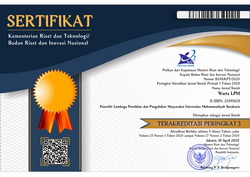Efektifitas Home Program untuk Meningkatkan Kekuatan Otot Ekstremitas Bawah dan Resiko Jatuh Bagi Lanjut Usia di Posyandu Lanjut Usia Dusun Plosokerep, Bendosari, Sukoharjo
DOI:
https://doi.org/10.23917/warta.v27i1.1878Keywords:
Education, home program, lower extremity muscle strength, elderlyAbstract
Background: The incidence of falls in the elderly is increasing in the elderly population in worldwide and has been recorded decreasing the quality of life in the elderly. Exercise programs can increase lower extremity muscle strength, improve postural balance and reduce falling risk. Objective: to determine the effectiveness of the home program in increasing lower extremity muscle strength and reducing falling risk among the elderly in Plosokerep Village, Bendosari, Sukoharjo. Methods: Used counselling and providing home programs for strengthening lower extremity muscles to the elderly in Plosokerep Village, Bendosari and evaluated those observed between 19 February to 19 March 2022. Results: The home program showed increasing lower extremity muscle strength effectively (p<0.001). The improvement of knowledge about the importance of lower extremity muscle strength was indicated by an increase of average of muscle strength assessed by 5XSTS. The average of lower extremity muscle strength increased from 15.08 seconds to 13.45 seconds. The number of elderly who had a high risk of falling decreased by 25%. Home program exercise of lower extremity muscle showed effective results in increasing lower extremity muscle strength (p<0.001) and decreasing falling risk. Conclusion: Home program exercise is effective to the elderly to improve muscle strength of lower extremity and diminish falls in the elderly.
References
Aagaard, P., Suetta, C., Caserotti, P., Magnusson, S. P., & Kjaer, M. (2010). Role of the nervous system in sarcopenia and muscle atrophy with aging: strength training as a countermeasure. Scand J Med Sci Sports, 20(1), 49-64. doi:10.1111/j.1600-0838.2009.01084.x
Ab Rahim, M., Tokhi, M., & Mohd Nasir, N. (2007). Modeling and Simulation of Sit-to-Stand Exercise. 15, 204-207. doi:10.1007/978-3-540-68017-8_53
Bijlsma, A. Y., Pasma, J. H., Lambers, D., Stijntjes, M., Blauw, G. J., Meskers, C. G., & Maier, A. B. J. J. o. t. A. M. D. A. (2013). Muscle strength rather than muscle mass is associated with standing balance in elderly outpatients. 14(7), 493-498.
Blau, H. M., Cosgrove, B. D., & Ho, A. T. (2015). The central role of muscle stem cells in regenerative failure with aging. Nat Med, 21(8), 854-862. doi:10.1038/nm.3918
Bobowik, P., & Wiszomirska, I. J. I. j. o. r. r. (2020). Diagnostic dependence of muscle strength measurements and the risk of falls in the elderly. 43(4), 330-336.
Brellenthin, A. G., Bennie, J. A., & Lee, D. C. (2022). Aerobic or Muscle-Strengthening Physical Activity: Which Is Better for Health? Curr Sports Med Rep, 21(8), 272-279. doi:10.1249/jsr.0000000000000981
Chakravarty, K., Chatterjee, D., Das, R. K., Tripathy, S. R., & Sinha, A. (2017). Analysis of muscle activation in lower extremity for static balance. Paper presented at the 2017 39th Annual International Conference of the IEEE Engineering in Medicine and Biology Society (EMBC).
Cho, K. H., Bok, S. K., Kim, Y. J., & Hwang, S. L. (2012). Effect of lower limb strength on falls and balance of the elderly. Ann Rehabil Med, 36(3), 386-393. doi:10.5535/arm.2012.36.3.386
Cuevas-Trisan, R. (2017). Balance Problems and Fall Risks in the Elderly. Phys Med Rehabil Clin N Am, 28(4), 727-737. doi:10.1016/j.pmr.2017.06.006
Desiana, I., Moeliono, M. A., & Prabowo, T. J. I. J. o. I. H. S. (2017). Effects of Quadriceps Strengthening Exercise on Quadriceps Muscle Strength and Its Relation to Lower Extremity Lean Mass. 5(2), 84-88.
Duchateau, J., & Enoka, R. M. (2011). Human motor unit recordings: origins and insight into the integrated motor system. Brain Res, 1409, 42-61. doi:10.1016/j.brainres.2011.06.011
Faulkner, J. A., Larkin, L. M., Claflin, D. R., Brooks, S. V. J. C., Pharmacology, E., & Physiology. (2007). Age‐related changes in the structure and function of skeletal muscles. 34(11), 1091-1096.
Goodpaster, B. H., Park, S. W., Harris, T. B., Kritchevsky, S. B., Nevitt, M., Schwartz, A. V., . . . Newman, A. B. (2006). The loss of skeletal muscle strength, mass, and quality in older adults: the health, aging and body composition study. J Gerontol A Biol Sci Med Sci, 61(10), 1059-1064. doi:10.1093/gerona/61.10.1059
Han, J., Waddington, G., Adams, R., & Anson, J. (2014). A proprioceptive ability factor underlying all proprioception tests? Response to Tremblay (2013). Percept Mot Skills, 119(1), 301-304. doi:10.2466/10.23.24.PMS.119c16z2
Handayani, S. P., Sari, R. P., & Wibisono, W. J. B. (2020). Literature review manfaat senam lansia terhadap kualitas hidup lansia. 8(2), 48-55.
Hauer, K., Becker, C., Lindemann, U., & Beyer, N. (2006). Effectiveness of physical training on motor performance and fall prevention in cognitively impaired older persons: a systematic review. Am J Phys Med Rehabil, 85(10), 847-857. doi:10.1097/01.phm.0000228539.99682.32
Hepple, R. T., & Rice, C. L. (2016). Innervation and neuromuscular control in ageing skeletal muscle. J Physiol, 594(8), 1965-1978. doi:10.1113/jp270561
Hlaing, S. S., Puntumetakul, R., Khine, E. E., & Boucaut, R. (2021). Effects of core stabilization exercise and strengthening exercise on proprioception, balance, muscle thickness and pain related outcomes in patients with subacute nonspecific low back pain: a randomized controlled trial. BMC Musculoskelet Disord, 22(1), 998. doi:10.1186/s12891-021-04858-6
Izquierdo, M., Martínez-Ramírez, A., Larrión, J. L., Irujo-Espinosa, M., & Gómez, M. (2008). [Functional capacity evaluation in a clinical and ambulatory setting: new challenges of accelerometry to assessment balance and muscle power in aging population]. An Sist Sanit Navar, 31(2), 159-170. doi:10.4321/s1137-66272008000300006
Kadi, F., & Ponsot, E. (2010). The biology of satellite cells and telomeres in human skeletal muscle: effects of aging and physical activity. Scand J Med Sci Sports, 20(1), 39-48. doi:10.1111/j.1600-0838.2009.00966.x
Karayannis, N. V., Smeets, R. J., van den Hoorn, W., & Hodges, P. W. (2013). Fear of Movement Is Related to Trunk Stiffness in Low Back Pain. PLoS One, 8(6), e67779. doi:10.1371/journal.pone.0067779
Kaya, D., Guney-Deniz, H., Sayaca, C., Calik, M., & Doral, M. N. (2019). Effects on Lower Extremity Neuromuscular Control Exercises on Knee Proprioception, Muscle Strength, and Functional Level in Patients with ACL Reconstruction. Biomed Res Int, 2019, 1694695. doi:10.1155/2019/1694695
Keller, K., & Engelhardt, M. (2013). Strength and muscle mass loss with aging process. Age and strength loss. Muscles Ligaments Tendons J, 3(4), 346-350.
Kim, B., & Yim, J. (2020). Core Stability and Hip Exercises Improve Physical Function and Activity in Patients with Non-Specific Low Back Pain: A Randomized Controlled Trial. Tohoku J Exp Med, 251(3), 193-206. doi:10.1620/tjem.251.193
Komalasari, D. R., & Arif, P. (2023). Peningkatan Pengetahuan tentang Cara Melakukan Latihan Fisik atau Olah Raga yang Aman Bagi Penderita Diabetes Mellitus. Warta LPM, 26(2), 207-217. doi:10.23917/warta.v26i2.1247
Kong, Y. S., Cho, Y. H., & Park, J. W. (2013). Changes in the activities of the trunk muscles in different kinds of bridging exercises. J Phys Ther Sci, 25(12), 1609-1612. doi:10.1589/jpts.25.1609
Kong, Y. S., Jang, G. U., & Park, S. (2015). The effects of prone bridge exercise on the Oswestry disability index and proprioception of patients with chronic low back pain. J Phys Ther Sci, 27(9), 2749-2752. doi:10.1589/jpts.27.2749
Lamboley, C. R., Wyckelsma, V. L., Dutka, T. L., McKenna, M. J., Murphy, R. M., & Lamb, G. D. (2015). Contractile properties and sarcoplasmic reticulum calcium content in type I and type II skeletal muscle fibres in active aged humans. J Physiol, 593(11), 2499-2514. doi:10.1113/jp270179
Larsson, L. (1983). Histochemical characteristics of human skeletal muscle during aging. Acta Physiol Scand, 117(3), 469-471. doi:10.1111/j.1748-1716.1983.tb00024.x
Madani, G. A. J. I.-R. J. (2019). Manfaat senam lansia terhadap upaya mengontrol gula darah yang berpengaruh pada aktivitas sehari-hari. 25.
Manangkot, M. V., Sukawana, I. W., & Witarsa, I. M. S. J. J. K. C. o. P. N. (2016). Pengaruh senam lansia terhadap keseimbangan tubuh pada lansia di lingkungan Dajan Bingin Sading. 4(1), 24-27.
McLean, R. R., Shardell, M. D., Alley, D. E., Cawthon, P. M., Fragala, M. S., Harris, T. B., . . . Dam, T. T. (2014). Criteria for clinically relevant weakness and low lean mass and their longitudinal association with incident mobility impairment and mortality: the foundation for the National Institutes of Health (FNIH) sarcopenia project. J Gerontol A Biol Sci Med Sci, 69(5), 576-583. doi:10.1093/gerona/glu012
Meretta, B. M., Whitney, S. L., Marchetti, G. F., Sparto, P. J., & Muirhead, R. J. (2006). The five times sit to stand test: responsiveness to change and concurrent validity in adults undergoing vestibular rehabilitation. J Vestib Res, 16(4-5), 233-243.
Miller, M. S., Bedrin, N. G., Callahan, D. M., Previs, M. J., Jennings, M. E., 2nd, Ades, P. A., . . . Toth, M. J. (2013). Age-related slowing of myosin actin cross-bridge kinetics is sex specific and predicts decrements in whole skeletal muscle performance in humans. J Appl Physiol (1985), 115(7), 1004-1014. doi:10.1152/japplphysiol.00563.2013
Mong, Y., Teo, T. W., & Ng, S. S. (2010). 5-repetition sit-to-stand test in subjects with chronic stroke: reliability and validity. Arch Phys Med Rehabil, 91(3), 407-413. doi:10.1016/j.apmr.2009.10.030
Moseley, G. L., & Hodges, P. W. (2006). Reduced variability of postural strategy prevents normalization of motor changes induced by back pain: a risk factor for chronic trouble? Behav Neurosci, 120(2), 474-476. doi:10.1037/0735-7044.120.2.474
Muñoz-Bermejo, L., Adsuar, J. C., Mendoza-Muñoz, M., Barrios-Fernández, S., Garcia-Gordillo, M. A., Pérez-Gómez, J., & Carlos-Vivas, J. (2021). Test-Retest Reliability of Five Times Sit to Stand Test (FTSST) in Adults: A Systematic Review and Meta-Analysis. Biology (Basel), 10(6). doi:10.3390/biology10060510
Narasimhan, M., Hong, J., Atieno, N., Muthusamy, V. R., Davidson, C. J., Abu-Rmaileh, N., . . . Rajasekaran, N. S. (2014). Nrf2 deficiency promotes apoptosis and impairs PAX7/MyoD expression in aging skeletal muscle cells. Free Radic Biol Med, 71, 402-414. doi:10.1016/j.freeradbiomed.2014.02.023
O'Sullivan, P. B., Phyty, G. D., Twomey, L. T., & Allison, G. T. (1997). Evaluation of specific stabilizing exercise in the treatment of chronic low back pain with radiologic diagnosis of spondylolysis or spondylolisthesis. Spine (Phila Pa 1976), 22(24), 2959-2967. doi:10.1097/00007632-199712150-00020
Papadopoulou, S. K. J. N. (2020). Sarcopenia: A contemporary health problem among older adult populations. 12(5), 1293.
Park, S. W., Goodpaster, B. H., Strotmeyer, E. S., Kuller, L. H., Broudeau, R., Kammerer, C., . . . Newman, A. B. (2007). Accelerated loss of skeletal muscle strength in older adults with type 2 diabetes: the health, aging, and body composition study. Diabetes Care, 30(6), 1507-1512. doi:10.2337/dc06-2537
Phelan, E. A., Mahoney, J. E., Voit, J. C., & Stevens, J. A. (2015). Assessment and management of fall risk in primary care settings. Med Clin North Am, 99(2), 281-293. doi:10.1016/j.mcna.2014.11.004
Priego, T., Martín, A. I., González-Hedström, D., Granado, M., & López-Calderón, A. (2021). Chapter Twenty - Role of hormones in sarcopenia. Vitamins and Hormones, 115, 535-570. doi:https://doi.org/10.1016/bs.vh.2020.12.021
Puntumetakul, R., Saiklang, P., Yodchaisarn, W., Hunsawong, T., Ruangsri, J. J. W. J. o. S., & Technology. (2021). Effects of Core Stabilization Exercise versus General Trunk-Strengthening Exercise on Balance Performance, Pain Intensity and Trunk Muscle Activity Patterns in Clinical Lumbar Instability Patients: A Single Blind Randomized Trial. 18(7), 9054 (9013 pages)-9054 (9013 pages).
Purves-Smith, F. M., Sgarioto, N., & Hepple, R. T. (2014). Fiber typing in aging muscle. Exerc Sport Sci Rev, 42(2), 45-52. doi:10.1249/jes.0000000000000012
Rahayu, U. B., Rahman, F., Setiyadi, N. A., & Azizan, A. (2021). Exercise and physical health in survivors of COVID-19: A scoping review. Journal of Medicinal and Chemical Sciences, 4(2), 154-162. doi:10.26655/JMCHEMSCI.2021.2.6
Rodgers, C., & Raja, A. (2019). Anatomy, Bony Pelvis and Lower Limb, Hamstring Muscle. doi:10.6084/m9.figshare.16682479.v1
Salari, N., Darvishi, N., Ahmadipanah, M., Shohaimi, S., Mohammadi, M. J. J. o. o. s., & research. (2022). Global prevalence of falls in the older adults: a comprehensive systematic review and meta-analysis. 17(1), 1-13.
Squire, J. (2019). Special Issue: The Actin-Myosin Interaction in Muscle: Background and Overview. Int J Mol Sci, 20, 5715. doi:10.3390/ijms20225715
Sukartini, T. J. J. N. V. (2007). Manfaat Senam Lansia Terhadap Kadar Imunoglobulin G (IgG). 2(1).
Svensson, J., Movérare-Skrtic, S., Windahl, S., Swanson, C., & Sjögren, K. (2010). Stimulation of both estrogen and androgen receptors maintains skeletal muscle mass in gonadectomized male mice but mainly via different pathways. J Mol Endocrinol, 45(1), 45-57. doi:10.1677/jme-09-0165
Tay, L., Ding, Y., Leung, B., Ismail, N., Yeo, A., Yew, S., . . . Chong, M. J. A. (2015). Sex-specific differences in risk factors for sarcopenia amongst community-dwelling older adults. 37(6), 1-12.
Tinetti, M. E., & Kumar, C. (2010). The patient who falls: "It's always a trade-off". Jama, 303(3), 258-266. doi:10.1001/jama.2009.2024
Utomo, B. (2010a). Hubungan antara Kekuatan Otot dan Daya Tahan Otot Anggota Gerak Bawah dengan Kemampuan Fungsional Lanjut Usia.
Utomo, B. (2010b). Hubungan antara kekuatan otot dan daya tahan otot anggota gerak bawah dengan kemampuan fungsional lanjut usia. UNS (Sebelas Maret University),
Vaishya, R., & Vaish, A. J. I. j. o. o. (2020). Falls in older adults are serious. 54, 69-74.
van der Merwe, C., Shultz, S. P., Colborne, G. R., & Fink, P. W. (2021). Foot Muscle Strengthening and Lower Limb Injury Prevention. Res Q Exerc Sport, 92(3), 380-387. doi:10.1080/02701367.2020.1739605
Visser, M., Goodpaster, B. H., Kritchevsky, S. B., Newman, A. B., Nevitt, M., Rubin, S. M., . . . Harris, T. B. (2005). Muscle mass, muscle strength, and muscle fat infiltration as predictors of incident mobility limitations in well-functioning older persons. J Gerontol A Biol Sci Med Sci, 60(3), 324-333. doi:10.1093/gerona/60.3.324
Wall, B. T., Gorissen, S. H., Pennings, B., Koopman, R., Groen, B. B., Verdijk, L. B., & van Loon, L. J. (2015). Aging Is Accompanied by a Blunted Muscle Protein Synthetic Response to Protein Ingestion. PLoS One, 10(11), e0140903. doi:10.1371/journal.pone.0140903
Whitney, S. L., Wrisley, D. M., Marchetti, G. F., Gee, M. A., Redfern, M. S., & Furman, J. M. (2005). Clinical measurement of sit-to-stand performance in people with balance disorders: validity of data for the Five-Times-Sit-to-Stand Test. Phys Ther, 85(10), 1034-1045.
WHO. (2015). World report on Ageing and Health. Retrieved from http://apps.who.int/
Yongtaek, K., Ki Soo, P., & Jun, Y. (2021). Associations between the quality of life in sarcopenia measured with the SarQoL® and nutritional status. Health Quality Journal, 19(1), 1-7.
Downloads
Submitted
Accepted
Published
How to Cite
Issue
Section
License
Copyright (c) 2024 Warta LPM

This work is licensed under a Creative Commons Attribution 4.0 International License.















